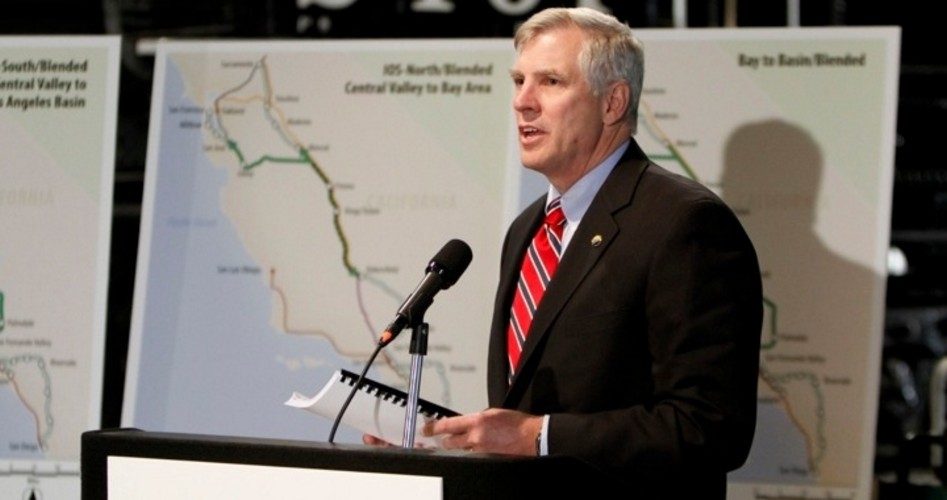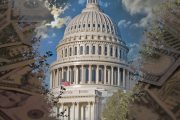
Disregarding the state’s mounting budgetary woes, California lawmakers green-lighted the first phase of construction on a controversial high-speed rail line that has become littered with financial hiccups and logistical roadblocks. Without a concrete plan for funding, the landmark rail line, the first of its kind in the United States, has been plagued with budgetary concerns, as private investments have become increasingly circumspect and as taxpayers bemoan the inevitable outcome of higher taxes to pay for the project.
Following years of heated legislative battles, California senators approved in a 21-16 vote on July 6 to allot some $8 billion for the project’s initial line of track, which is slated to operate trains at speeds of up to 220 miles per hour. The vote approved $4.5 billion in state funding and provided $3.2 billion in federal bond money.
“The legislature took bold action today that gets Californians back to work and put California out in front once again,” Governor Jerry Brown asserted following the vote.
Proponents say the high-speed rail line will lessen environmental damage, ease dependence on foreign oil, generate thousands of jobs, and ignite an explosion in economic growth for California businesses. U.S. Transportation Secretary Ray LaHood added his support, lauding the initiative for its purportedly meaningful contribution to the state’s economy. “I congratulate the Legislature on taking this action, which will create thousands of jobs and strengthen the California economy,” LaHood noted in a blog post. “In the next 20 years, California expects more than 7 million additional residents. But, as the state’s residents know all too well, the highways between California cities are already congested, and short-haul takeoff and landing slots at Golden State airports are at a premium.”
Meanwhile, Republicans and other critics blasted the decision, highlighting the state’s already floundering fiscal status and looming tax increases for California residents. Most consequential, at least to many opponents, is the project’s devastating impact on California education, as the education budget would be cut to help pay for the new rail line. “Closing schools for three weeks while spending $8 billion on 130 miles of train tracks defies logic and is irresponsible,” Senate GOP leader Bob Huff charged, echoing his colleagues’ rallying cry for slashing spending.
“It’s unfortunate that the majority would rather spend billions of dollars that we don’t have for a train to nowhere than keep schools open and harmless from budget cuts,” Republican Senator Tom Harman added.
In an attempt to override budget constraints, supporters of the project pitched an updated proposal in April to lawmakers and the general public. The revised plan narrowed the scope of the project while expediting construction to save money. In a previous article, The New American reported on the revised plan while noting the project’s evolving price tag:
The newly minted plan expedites completion of the first true U.S. high-speed rail system, moving it to 2028, trimming the project timeline by five years and shaving $30 billion off the original budget drafted last year by the California High-Speed Rail Authority. In 2008, when residents first voted to authorize the bonds, they were told the overall cost of the project would be $45 billion — and four years later, the total became $98 billion. The new proposal has reduced that number to $68.4 billion, still $23.4 billion more than the original total.
Despite proponents’ efforts to tout cost savings, the rail system leans heavily on questionable government funding and speculative private-sector investments, leaving California residents with a fluctuating tax bill. “We’ve seen numbers in the $30 billion, $40 billion, the $90 billion range, and now we’re back in the $60 billion range,” Sen. Joe Simitian (D-Palo Alto) said at the time. “I think there is understandably both some confusion and skepticism about what is the system going to cost, and then there’s the question of where is the money going to come from?”
Lawmakers and other critics are not alone in their opposition to the costly project, which has an estimated price tag of $68 billion. Furthermore, farmers whose land occupies the path of the expansive infrastructure project are ramping up efforts to stall the rail line, as farm bureaus in Madera and Merced counties have filed a lawsuit to prevent the rail line from impeding on their businesses. The suit’s plaintiffs contend that the train would ruin 1,500 acres of fertile land resulting in the disruption of 500 agricultural businesses. “We are going to protect our property,” charged Frank Oliveira, a farmer who has been active in protesting the project.
Some observers are warning that the project’s latest development could impair Gov. Brown’s proposed tax increase on the November ballot, which asks for a temporary rise in income taxes on earners making more than $250,000 a year and increased sales taxes on all California residents. A Field Poll conducted previous to last week’s vote reported that support for Brown’s tax proposal could drop precipitously if legislators approved funding for the high-speed rail.
Reporting on the rail system’s reputation for spiraling costs , The New American cited a recent survey showing the degree of voters’ remorse on the part of residents who are questioning California’s spendthrift legislature:
Voters in the state are turning on the project, as a new poll conducted by USC-Dornsife and the Los Angeles Times found that 55 percent of California voters want the $9-billion bond issue — which was approved in 2008 to fund early stages of the rail system — back on the ballot. And a startling 59 percent affirmed that they now would vote against it.
Photo of California High-Speed Rail Authority chairman Tom Umberg: AP Images



